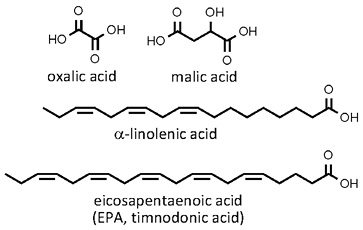 Portulaca oleracea
Portulaca oleracea
purslane
Back to “Salad herbs and herb mixtures: purslane (Portulaca oleracea)”
Portulaca oleracea L. (Portulacaceae); postelein, porslein (Afrikaans); pourpier (French); Portulak, Sauburzel (German); verdolaga (Spanish)
DESCRIPTION Thick fleshy stems, often tinted red, bearing small to medium-sized, succulent leaves with a slightly sour taste.
THE PLANT A weedy annual herb with small yellow flowers opening only for a few hours in the morning. Two basic types are recognized: a variable wild form (subsp. oleracea) with ground-hugging stems and small leaves, and a domesticated variant (subsp. sativa) with a more upright habit and larger, yellowish green leaves.1
ORIGIN Purslane is a cosmopolitan annual and one of the top ten worst weeds in the world.1 It was apparently present in North America even in pre-Columbian times. The use of purslane dates back to Roman times. It has been used in Europe for pickles since the Middle Ages.2 The cultivated forms originated in Europe and have become more popular in recent years. One of them, ‘Claytone de Cuba’, is grown in France and Belgium.2
CULTIVATION Purslane is easily grown from seeds. It adapts to any soil type (even poor, compacted soil) and will grow under almost any environmental conditions.
HARVESTING Leafy stems are picked from the garden or wild-harvested as required. They are sometimes available at local farmers’ markets. The plant uses the crassulacean acid photosynthetic pathway and therefore forms malic acid during the night. Leaves harvested in the early morning will tend to be more acidic than those picked in the afternoon, when the malic acid has already been metabolised.
CULINARY USES The acidity, spicy flavour and slimy consistency make purslane an old favourite for stews. It is incorporated in fresh salads and may be cooked on its own like spinach or okra, and served with butter, cream or gravy.2 Leaves can be used as an edible garnish for soups, omelettes and meat dishes in the same way as watercress.2 French cooks sometimes use fresh leaves to flavour béarnaise (a hot, creamy sauce made from egg yolks, vinegar and butter) or a version thereof known as paloise.2
FLAVOUR COMPOUNDS The sour and salty taste is linked to oxalic acid (23 mg/g in the fresh raw leaf but much reduced by cooking or pickling)3 and also to malic acid in daily fluctuations. The herb is exceptionally nutritious, partly due to high levels of omega-3 fatty acids (claimed to be the highest level of all plants)1 with 1.5−2.5 mg/g of fresh mass in leaves, 0.6−0.9 mg/g in stems and 80−170 mg/g in seeds.3 The major compound is α-linolenic acid, representing 60% and 40% of total fatty acids in leaves and stems, respectively.3 Also present is the structurally related but non-essential eicosapentaenoic acid (also known as EPA or timnodonic acid), which has shown potential in the treatment of inflammation and depression.

NOTES Two North American members of the Portulacaceae are occasionally cultivated: winter purslane, also known as miner’s lettuce or Cuban spinach (Montia perfoliata), and talinum also called flameflower or waterleaf (Talinum triangulare).
1. Mabberley, D.J. 2008. Mabberley’s plant-book (3rd ed.). Cambridge University Press, Cambridge.
2. Larousse. 1999. The concise Larousse gastronomique. Hamlyn, London.
3. Poeydomenge, G.Y., Savage, G.P. 2007. Oxalate content of raw and cooked purslane. Food, Agriculture and Environment 5: 124−128.
4. Liu, L., Howe, P., Zhou, Y.F., Xu, Z.Q., Hocart, C., Zhan, R. 2000. Fatty acids and beta-carotene in Australian purslane (Portulaca oleracea) varieties. Journal of Chromatography 893: 207−213.